
Aviation Bomb Manufacture
Many factories, operating under several distinct Ministries within the Soviet bureaucracy, engaged in the production of aviation bombs during the GPW. Indeed, there were by far too many to list here [for example, in January 1940 no less than nine factories were involved in the manufacture of bombs, or components, of the FAB 50 type]. However, three main factories were responsible for much of the development of Soviet aviation bombs, not to mention a healthy proportion of production. The primary centre for all bomb manufacture and development was Zavod 67 (NKTP) in Moscow, which included a Scientific-Research Bureau, or "NIO". This NIO-67 was responsible in the main for the development of new aviation bombs, and also was tasked with the preparation of drawings of actual production specimens showing the factual development of these weapons. Another major factory was Zavod 12 (NKTP) imeni Sverdlova, which was often involved in bringing new munitions into series production, and Zavod "Rostel'mash" (NKSM) which was a huge factory engaged in bomb development as well as manufacture.
Soviet aviation bombs were assigned a designation which was eminently logical and straightforward. The bomb name derived firstly from the type of the munition, in the case of the FAB 50 this being "FAB", which stood for fugasnaya aviabomba, or high-explosive aviation bomb. The following number indicated the weight of the munition, in kilograms. There was often a suffix following the weight cipher, this indicating a sub-type of munition, special series, and all other manner of class designation (as will be demonstrated).
As regards external appearance, Soviet aviation bombs were, curiously, finished twice at the factory where they were manufactured. All bombs were first completed with a full set of markings and ciphers relevant for the specific time frame and factory practice of manufacture. These changed repeatedly, and are so voluminous so as to be impossible to contemplate here. The bombs were usually painted with a type of industrial paint, in most cases whatever happened to be available at the factory and in customary use. A few factories (Zavod 48 NKTS is one such), these usually later on the in GPW era, always seemed to have finished the bombs with aviation-type ALG primers (ALG-1, and -5), but this was most certainly an exception to the usual practice. The typical painted surfaces were mainly either Industrial Metal Primer (the light blue-green primer known from aviation and other manufacture), a ubiquitous medium blue paint of unknown nomenclature seen throughout Russia even to this day, or in the immediate pre-War years an unpainted metal surface.
Having been painted, thus, and given a full set of appropriate number-text markings, the bombs were then completely painted again with lacquer No.67 asfaltoviy (a cognate for asphalt, describing the paint's colour). The lacquer's name would seem to have been derived from the factory's number where it was developed, and the colour was indeed a dark-ish grey resembling asphalt. The lacquer No.67 was applied over the entire munition (the mounting strap and fuse being added subsequently), often quite thickly, obscuring entirely the previously applied markings and colouration. Lacquer No.67 possessed water repellent properties, and the intention was clearly to seal the bomb externally from the possible encroachment of moisture. This finish was slightly 'sticky' to the touch, and one may always see large amounts of dirt and grass clinging to the surface of any bomb which was placed on the ground. It is noted that lacquer No.67 could be removed easily by wiping the surface with turpentine; one presumes that this would be done to check the bomb's markings when required.
However, one may also see bomb examples with no application of lacquer No.67. In many photographs where bombs were used in testing or evaluation situations, the bombs can often be seen in their original finish. Some types of munitions which could be assembled in the field (see below) might also appear without the grey protective lacquer.
The FAB 50
The smallest calibre of munition in the FAB series were the FAB 50 type bombs. This series was exceedingly widely employed during the GPW, indeed probably by every aircraft in the VVS inventory capable of carrying a bomb. The FAB 50 series were highly developed during the course of the War, and in fact often included a range of munitions which were not even bombs, or indeed manufactured in the USSR. A general trend through the War years, as well, involved the increase in weight of the production FAB 50 munition. The early classic models, with their notable teardrop shape, weighed exactly 49.67 kg, as the bomb type name would suggest. However, by 1943 the usual FAB 50 actually tipped the scales at 60-63 kg, and these were not even the heaviest of the series! The designation "FAB 50" remained unchanged, however, as with so much of Soviet developmental manufacture during the GPW.
All FAB 50 munitions shared some common features. All weapons of this family were armed with a single fuse. There were many fuse types in use-- far too many to list here-- but all of these were mounted in the nose of the FAB 50 and featured a 'windmill' type arming mechanism. As well, all FAB 50 bombs were mounted via a single steel strap, fastened roughly midway along the length of the munition (at the c.g. one would assume). It was therefore possible to mount any bomb of this family on any rack accommodating the FAB 50 series, increasing their versatility.
The following are representative examples of the main
series of FAB 50s employed during the GPW. An exhaustive listing would be
virtually impossible, as would an explanation of every minute modification throughout
their manufacture. Bearing this caveat in mind, these example may be seen however
as a useful sample.
FAB 50SV 1940
| Length: 941 mm Max. Diameter: 240 mm Overall Weight: 49.76 kg |
 |
The 'classic' FAB 50 bomb for many students of the VVS RKKA is this munition, the FAB 50SV. This type was manufactured, virtually unchanged, from 1930 until 1942, and exhibited a delightful teardrop shape which is immediately recognisable in any photograph. The model depicted here is typical of manufacture from 1940, and is finished in the ubiquitous medium blue Soviet industrial paint.
This bomb featured a three part main assembly, with the body riveted together just aft of the joint strap. The tail cone was welded onto the munition, and the stabilizing fins were riveted.

FAB 50ShG 1943
| Length: 938 mm Max. Diameter: 240 mm Overall Weight: 49.6 kg |
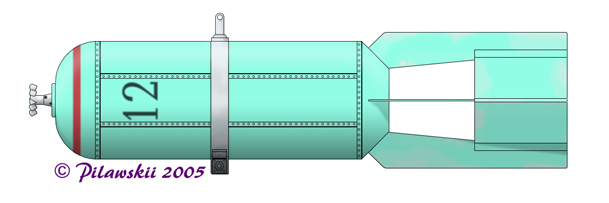 |
Manufacture of the SV model gave way gradually to the FAB 50 ShG bomb. This munition was curious in being highly riveted, with the main body consisting of 5 pieces. The ShG retained the weight and basic dementions of the earlier SV, and was filled with an identical amount of explosive. The model depicted here is typical of manufacture from 1942-43, and is finished in Industrial Metal Primer, which was very widely use for bomb production.
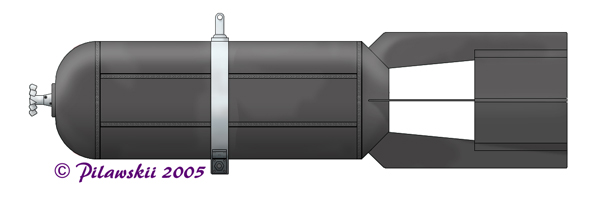
FAB 50TsK 1940
| Length: 950 mm Max. Diameter: 219 mm Overall Weight: 60 kg |
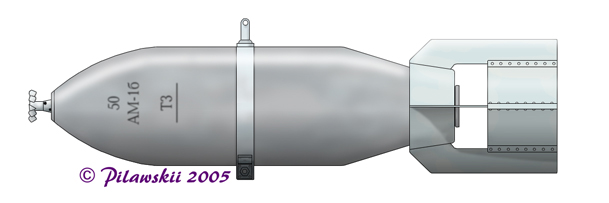 |
The earlier riveted FAB 50 bombs were seen to represent a manufacturing anachronism, and a munition with a fully cast casing was developed during the late 1930s. The TsK series [TsK = tseliy korpus, or 'one-piece main body'] appeared as early as 1939, but despite this fact the older models bombs continued well on in production. The model depicted here is typical of manufacture from 1940, and is finished in an unpainted condition.
The TsK featured a one-piece main assembly which was cast. The tail cone was threaded onto the munition's aft end, and the stabilizing fins were riveted. This new series of FAB 50 were conceived as being much more of a penetrative munition than the earlier models (not quite semi-armour piercing, but in that direction), and consequently the outer casing was much thicker (and thus heavier) than before, especially around the nose section. The weight of the bomb incresed some 10 kg, this all resulting from the heavier cast body.
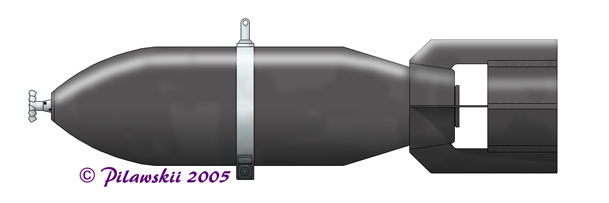
The TsK models were extremely similar to the FAB 50SL bombs manufactured
at Zavod "Rostel'mash" during the same period. Indeed, the two are rather
difficult to separate visually, though the latter munition tended to be slightly
heavier (around 63-65 kg).
FAB 50SCh 1944
| Length: 920 mm Max. Diameter: 219 mm Overall Weight: 65.40 kg |
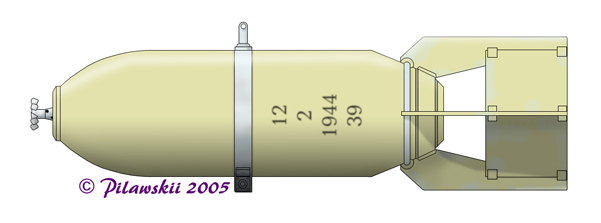 |
If the TsK model was seen to be a 'beefed up' FAB 50 munition, the later SCh was indeed a Heavyweight. The new model appeared in 1943, and very quickly displaced manufacture of all preceding FAB 50 bombs. The example depicted here is typical of manufacture from 1944, and is finished in aviation lacquer ALG-1 (which was not overly common).
The SCh's nose section was reinforced even more than the TsK, whilst the diameter was reduced. The new tail section contained only the stabilizing fins, these being mounted to the bomb via steel band. The increased casing thickness rendered the SCh a fully qualified semi-armour piercing munition, even if the type's designation did not indicate the fact. However the FAB 50SCh was effective against lightly armoured vehicles, as was often used in this role during the latter half of the GPW.
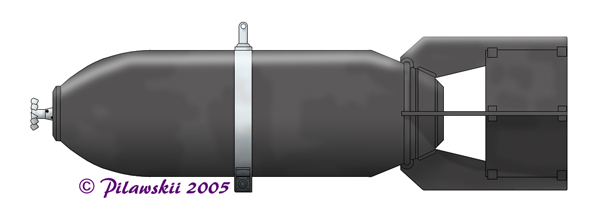
FAB 50m9 1941
| Length: 966 mm Max. Diameter: 152 mm Overall Weight: 42 kg |
 |
During the 1930s much thought and experimentation was undertaken in the USSR on the matter of emergency contingencies in the case of war. These ideas were active in the production of aviation bombs, as in all sectors of industry.
The idea to utilize outdated or surplus artillery shells as 'emergency' aviation bombs was not new. Indeed, the same technique had been used abortively during the Russian Civil War by both sides, albeit with more casualties resulting from accidents than from enemy attack. However, artillery shells were very much improved during the 1930s, and it was thought that these could be safely employed as bombs. As a result, the "m" series of FAB bombs were launched [m = model, or 'model'] during 1935-36.
Experiments were conducted on many types of shell, and of various sizes. With regards to Soviet artillery shells, the most suitable type was found to be the 152 mm variety. The example shown here is a "model 9", using the Soviet 152 mm shell, and painted in Army 4B0 Green. The shell was fused with an aviation type 'windmill' unit, and sheet metal fins were bolted onto the base. Though simplistic, the flight properties of the munition were not seen to be radically different than that of the usual FAB 50.
Limited Series manufacture of these FAB50 "m" models was periodically undertaken at several factories. The idea seemed to have been to keep emergency production procedures in practice, and also to stimulate improvements in these types of bombs. Such weapons do appear in the photographic record, in fact, with the U-2VS being the preferred customer for them.

FAB 50TR 1942
| Length: 920 mm Max. Diameter: 152 mm Overall Weight: 45 kg |
 |
The use of aviation shells as make-shift bombs is curious enough. However, the manufacture of 'emergency' bombs in series using captured material is something quite different! Remarkably, in the GPW-era USSR, such unusual measures were undertaken.
The FAB 50TR series were all munitions produced using foreign artillery shells. There were a host of different models, some using shells abandoned by the French and British during their invasions of the USFSR! Many German shells were used in this way, as well, but by far the favourite items for this purpose were those captured from Romanian units.
The 105 mm and 152 mm Romanian shells were both used, with the latter being manufactured in limited series. The fins were attached to the base of the shell with a clamp device, and this item could be affixed by units in the field. Indeed, this was done-- bombs of this very type were lashed up by the defenders of Sevastopol and dropped on the same enemy soldiers who had lost them. Curiously, the Romanian 152 mm shell was regarded as being an effective bomb, and all of the stocks of these captured munitions were eventually used. Many examples were employed without a coating of lacquer No.67, which was seen only on factory produced models.
